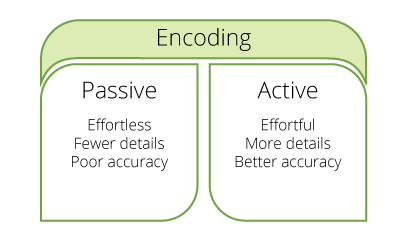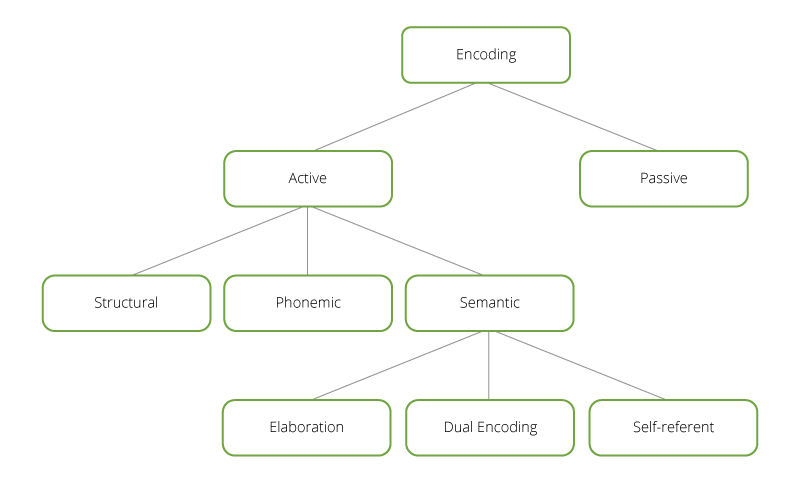1st process of Memory
Encoding (Memory)
https://contensis.uwaterloo.ca/sites/courses/PSYCH-101/lecture-content/module-1/1c.aspx
Because memory ultimately takes place in the brain, the first process of memory converts various types of information (the concert you performed, the lyrics to a song, or finger movements producing an “A” chord on guitar) into neuronal impulses. This process is called Encoding.
 Encoding can either be passive or active:
Encoding can either be passive or active:
- Encoding is Passive when no effort is invested in remembering the information. Because this is a very shallow form of encoding, some information can be remembered, but most will be lost or remembered inaccurately.
- Ex: when you watch television or read a book
- Encoding is Active when effort is expended to process the information for later use. These forms of encoding lead to superior memory performance later on because they require deeper levels of processing.
- Ex: when you are taking notes, reflecting on information, or studying for an exam.
Forms of Active Encoding
Some forms of active encoding can lead to deeper processing (and better memory) than others.
- Structural encoding questions asked participants something about the physical structure of a word.
- Phonemic encoding questions asked participants something about what the word sounds like.
- Semantic encoding questions asked participants something about the meaning of the word.
And the type of encoding results in higher retention.

Focusing on the meaning of a word (Semantic Encoding) led to the best recall in the Craik and Tulving study. However, there are Enrichment techniques that can be used to process information even deeper, leading to still better memory.
The 3 techniques:
- Elaboration
- Self Referent Encoding
- Dual Encoding
Elaboration
Elaboration is a form of semantic encoding that aids the recall of new information by connecting it to existing information. For example, using a metaphor to draw parallels between new concepts and existing concepts.
Self Referent Encoding
Information that is connected to us is easier to remember. Self Referent Encoding is a form of semantic encoding that aids the recall of new information by connecting it to oneself. For example can you think of somebody famous born on your birthday? Can you think of somebody famous born on your best friend’s birthday? Most people can do the former but struggle with the latter.
- This is what I do when I learn new concepts
Dual Encoding
Dual Encoding is a form of semantic encoding that aids recall of information by producing redundant (more than one) codes. For instance, if you were tasked to remember the word “Frog”, you might create a mental image of Kermit the Frog. Now you would have two codes for the same information, a word and a mental image. Either one (or both) can lead you back to the information.
